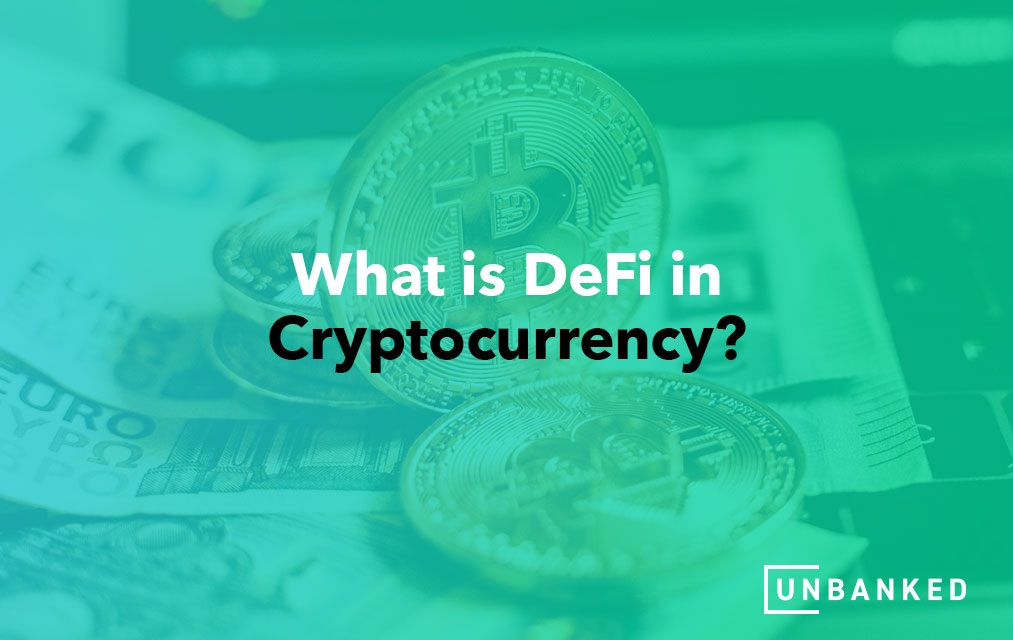Decentralized Finance (DeFi): The Basics You Should Know
Decentralized finance (DeFi) is a type of system through which different types of financial products steadily become available on public desensitized blockchain networks. Once they are present on the blockchain, they become open for anyone to access and use without an intermediary. These middlemen typically include brokerage accounts or banks. This also means that things like Social Security numbers and government-issued identification are not required for someone to use DeFi. To put it in more specific terms, DeFi is an umbrella category that refers to various applications within the realms of blockchain and cryptocurrency. Specialized software written onto a blockchain allows lenders, sellers, buyers, and borrowers to communicate in one of two ways without the involvement of an institutional middleman. These communications occur through direct peer-to-peer interactions or through a software-based mediator (rather than an actual institution or company) that facilitates the transaction between the involved parties.
DeFi systems allow for removing intermediaries between parties engaging in a transaction, regardless of the kinds of platforms or technologies used in the process. As a result, DeFi is not controlled by a single business, entity, or another type of central source. This removes the limitations of speed and sophistication that are often put onto transactions going through a centralized system operated by human gatekeepers. Not only does this expand the use of blockchain from simple value transfers to more complex financial interactions, but it also offers users the power to have and maintain more direct control over their money throughout a transaction.
Related: Why High-Risk Businesses Use Cryptocurrency
What Are the Components of DeFi?
The components that make up DeFi are, generally speaking, the same as they are for any financial ecosystem. In short, they require the use of a conventional, stable currency, as well as a range of use cases, meaning the participation of individuals who actively make use of that currency). DeFi components often take a few different forms, most commonly stablecoins. However, they also come in the form of a variety of services, including crypto exchanges and lending services. Smart contracts, the automated, self-executing agreement terms between borrowers, lenders, buyers, and sellers, provide the specified frameworks for how DeFi apps function due to the encoded terms and conditions required for these services to work.
The individual components of decentralized finance systems are all a part of a unique software stack, and each layer is tasked with performing a specific function in constructing the overall DeFi system. Said DeFi systems are built upon a four-layer structure that, together, allow for the construction and presence of unique DeFi applications that can each serve a range of special functions. The four layers that comprise DeFi stacks include the settlement layer, the protocol layer, the application layer, and the aggregate layer. Each is essential in supporting the range of various functions built within and provided by the DeFi system. The following are brief summarizations regarding what each layer is responsible for:
The Settlement Layer
Also commonly referred to as layer 0, this layer serves as the foundation upon which all other DeFi transactions can occur. It’s made up of a public blockchain and that blockchain’s native cryptocurrency, which is also the crypto used to settle transactions that appear on the DeFi application. A typical example of this layer is Etherum (which will be discussed in more detail later) and its ether (ETH) token. This layer can also utilize tokenized assets, including physical currencies (like the U.S. dollar) and other representations of real-world assets (like the ownership of a piece of land).
The Protocol Layer
This layer involves software protocols, standards, and rules written into the blockchain to govern the requirements of specific activities and tasks while also providing liquidity to the DeFi ecosystem. It serves as the guidelines and regulations that all entities working on the blockchain agree to abide by. Because DeFi protocols are designed to be interoperable, they can be used by many entities at once to build a practical application or service.
The Application Layer
The application layer of the DeFi stack is where all of the consumer-facing applications reside. These applications serve to abstract the underlying protocols from the previous layer into simplified, consumer-focused services. Several applications exist within this layer, but the most common revolves around cryptocurrency’s ecosystem, including decentralized crypto exchanges and lending services.
The Aggregation Layer
This final layer of the DeFi stack comprises aggregators who actively connect the applications involved in the previous layer to provide investors with specialized services. Such services can include the seamless transfer of funds between different financial parties or instruments to maximize investors’ potential returns, but lending and borrowing are the most common services provided within the layer, generally speaking. Other examples also include the services offered by crypto wallets and also banking services.
Related: The Importance of Cryptocurrency Education for Businesses
What Can You Do With DeFi?

DeFi offers decentralized alternatives to a whole host of financial services. When utilized alongside Ethereum (again, this will be discussed in more detail later), it provides users with an ever-growing selection of options for creating new and unique financial products and services. Some of these services include:
- Receiving and sending money around the world
- Accessing stable, global currencies
- Buying cheaper, easier to pay, and more transparent insurance
- Growing and managing your portfolio
- Trading and lending tokens on a market that’s open 24/7, 365
- Funding your business and financial ideas (through Ethereum crowdfunding and other fundraisers)
- Borrowing funds with and without collateral
- Start and manage cryptocurrency savings
- Providing access to advanced trading methods that give traders more control over their transactions
Are you curious about the power and potential of cryptocurrency and what it has the potential to do for your financial future? Take a look at the top-quality education articles provided by unBanked to learn more today.
Are There Risks to DeFi Investing?
Alongside all the benefits that DeFi provides its users, there are also a few risks that it has the potential to create. People should be fully acquainted with these potential risks before utilizing DeFi systems to adequately determine whether they are comfortable taking on such risks or not. For example, DeFi systems place power and control on the user’s hands, and generally, there is no sort of central authority that controls the entirety of the system. This lack of management means that there isn’t anyone that users can reach out to who can help them if they encounter any technical issues, such as with a lost password or a damaged computer.
Because of this, all users must develop robust contingency plans for using, sorting, and backing up data and comprehensive account information. Additionally, many commonly used strategies within the realm of DeFi tend to contain very high levels of volatility due to several factors, including the presence of technical and security risk factors. So, again, it’s essential that potential users fully understand these potential risks and drawbacks before using any DeFi systems or applications.
DeFi vs. Traditional Finance
A great way to better understand DeFi is to compare how it operates to more traditional types of finance and look at how it solves many problems that people tend to encounter with conventional finance. For example, a large portion of the population doesn’t have guaranteed access to bank accounts or the use of other types of specialized financial services. Still, anyone who wants to use DeFi can easily do so. There’s also the fact that traditional finances are frequently limited in terms of trading hours within specific time zones, and any financial transactions can take days to complete due to how traditional financial institutions tend to operate. However, as stated in the previous section, DeFi markets are constantly open throughout every day of the year and never close, and transactions can occur much more quickly due to DeFi’s inherent removal of slow and potentially costly intermediaries as part of transactions. This difference means that they can occur in only a few minutes rather than a few days.
Other significant differences include the fact that, in traditional finance, your money is held by specific companies. Through DeFi, you’re able to maintain a hold on your finances and don’t have to rely on such companies. You keep complete control over your finances and get to determine where the money goes and how it’s spent. Additionally, DeFi systems are built on a model of transparency. This means that anyone can look through a product’s date and figure out how the system works. More traditional financial institutions, however, are closed off to outside observation. These factors play a significant role in the effectiveness and general accessibility of DeFi applications and systems.
Related: Cryptocurrency’s Potential to Transform Banking Systems
DeFi Ethereum Applications

The majority of applications working on a DeFi system (and refer to themselves as DeFi) are built atop the world’s second-largest cryptocurrency platform, Ethereum. This platform is unique and sets itself apart from other cryptocurrency platforms, such as Bitcoin, through its ease of use in general. It purposefully makes it much easier to construct other DeFi applications for purposes beyond basic financial transactions. This ease is primarily due to the platform’s use of smart contracts, which allow for heightened levels of flexibility and control on the part of users. We may soon be witnessing further advancements in DeFi Ethereum capabilities (especially regarding scalability) with the launch of the Ethereum 2.0 upgrade that will soon be applied to the system’s underlying network. This update will facilitate the development and launch of several powerful new DeFi applications in the future. Until then, however, some of the most popular types of DeFi applications connected to Ethereum include:
Stablecoins
Stablecoins are a specialized type of cryptocurrency directly tied to assets outside of the cryptocurrency itself to help stabilize its price over time. They can be tied to a real-world currency, like the U.S. dollar, or the price of a specific commodity, like gold, platinum, or silver. Stablecoins can provide their users with price stability through backing, otherwise known as collateralization, and through various algorithmic mechanisms that control the selling and buying of reference assets and their derivatives.
Decentralized Exchanges (DEXs)
Decentralized online exchanges allow users to connect with one another and exchange different types of currencies (both physical and virtual) without intermediary involvement. For example, U.S. dollars could be exchanged for bitcoin, ether, DAI, or any other type of currency that a user could be interested in.
“Wrapped” Bitcoins (WBTC) and Lending Platforms
WBTC is a way of sending bitcoin to an Ethereum network, allowing the bitcoin to be directly used within the Ethereum DeFi system. This enables users to earn interest on the bitcoin cryptocurrency that they choose to lend out through decentralized lending platforms, which utilize smart contracts to replace intermediaries, like banks, directly.
Prediction Markets
Prediction markets allow users of DeFi applications and systems to bet on the outcome of future events, including government elections results, the chance that a proposed bill or policy will be accepted and passed by legislature, and even the results of major sporting events, like football and basketball. The overall goals of DeFi prediction markets are to allow this same sort of betting functionality without the involvement of intermediaries.
Would you like to discover more information about the capabilities of cryptocurrency and the role that it may play in helping you advance your future financial prospects? Check out the vast array of educational resources offered by unBanked today to find out more.





